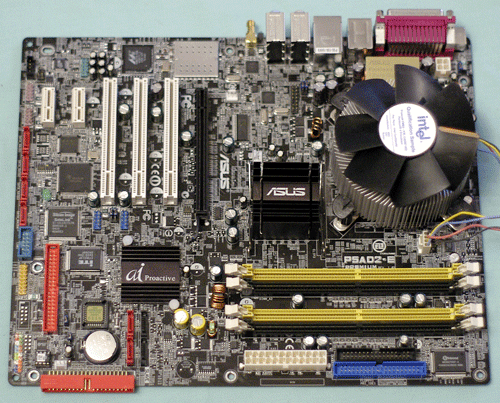FIRST LOOK: Asus P5AD2-E - 1066FSB & DDR2-711
by Wesley Fink on November 29, 2004 12:01 AM EST- Posted in
- Motherboards
Basic Features
The P5AD2 has one of the most complete selections of BIOS adjustments and board features that you will find on a Socket 775 motherboard. Therefore, Asus had no real need to include additional features on the P5AD2-E. The changes that were made are generally enhancements to existing options, like extending the chipset voltages and memory voltages and providing finer adjustments.| Asus P5AD2 Premium Motherboard Specifications | |
| CPU Interface | Socket 775 Pentium 4 (Prescott) |
| Chipset | Intel 925XE/ICH6R |
| FSB Speeds | 1066, 800 |
| Clock Speeds | 100MHz to 400MHz (in 1MHz increments) |
| PCI Speeds | To CPU, 33.33, Auto |
| DDR2 Speeds | Auto, 400, 533, 711 |
| Core Voltage | 1.4375V to 1.6125V in 0.0125V increments |
| DRAM Voltage | 1.80V to 2.20V in 0.05V increments |
| Chipset Voltage | Auto, 1.5V to 1.8V in 0.05V increments |
| FSB Termination Voltage | Auto, 1.2 to 1.5V in 0.05V increments |
| Memory Slots | Four 240-pin DDR2 Slots Dual-Channel Unbuffered Memory to 4GB |
| Expansion Slots | 1 PCIe x16 Slot 2 PCIe x1 slot 3 PCI Slots |
| Onboard SATA/IDE RAID | 4 SATA 150 drives by ICH6R Can be combined in RAID 0, 1, Intel Matrix PLUS 4 SATA 150 RAID by Sil3114R RAID 0, 1, 10, 5 |
| Onboard IDE | One Standard ATA100/66 by ICH6R (2 100/66/33 drives) Plus One IDE RAID by ITE 8212F (2 133/100/66, RAID 0, 1, JBOD) |
| Onboard USB 2.0/IEEE-1394 | 8 USB 2.0 ports 3 IEEE 1394b FireWire Ports by TI 1394b |
| Onboard LAN | 2 X Gigabit PCIe LAN Both by Marvel 88E8053 |
| Onboard Audio | CMedia CMI9880 (Intel HD) 8-Channel with SPDIF in/out |
| Wireless LAN | WiFi 802.11g Included |
| Tested BIOS | 1005 Beta 002 |
The one surprise in the Asus update to the P5AD2-E is the reduced range of CPU voltages. The original P5AD2 provides a vCore range from 1.4375V to 1.7875V, where the new -E version is just 1.4375V to 1.6125V. That's an adequate range, but it seems the wrong way to be going for top-line options. We hope that Asus will correct this in a BIOS update.

The Asus 925XE/925X boards are Premium boards - clearly top-of-the-line in every way. All of the Asus Proactive AI (Artificial Intelligence) features are included. This includes a special cooling plate on the bottom of the board in the CPU area that Asus calls Stack Cool.

Features are all but identical to the P5AD2, with both LAN ports powered by the new Marvel 88E8053 Ethernet controllers on the faster PCI Express bus. The P5AD2-E includes a complete WiFi setup with embedded (built into the board) 802.11g capabilities and an external antenna. You will also find 3 of the high-speed "b" versions of IEEE 1394 firewire, which promise double the speed of 1394a ports. Speed-step, a new Intel feature that allows the CPU to be downclocked to 14 for FSB/memory overclocking or cooler operation, is another Asus feature.
The premium C-Media CMI9880 codec supports the Intel High-Definition audio, with 8 channels and Dolby Digital Live technology support. The CMI9880 is the only audio solution we've seen that has a built-in Dolby AC3 encoder. The encoder can actually encode your digital audio into Dolby digital streams, which can be output to the SPDIF for Dolby Digital playback. The CMI9880 does this real-time for any digital audio in your system to feed Dolby Digital playback. Asus carries High-Definition (Azalia) audio further on the P5AD2-E and the P5AD2 than any other 925XE/925X board that we have seen.
The storage area is one area where the Asus stands above the crowd. All of the 925X/925XE boards support the ICH6R standard 4 SATA/1 IDE (2drives) configuration. The P5AD2/-E boards add 4 more SATA ports for a total of 8 SATA ports. They go even further by adding an ITE controller for 2 more IDE devices for a total of 4. Asus even includes a slot-mounted external SATA adapter for converting 2 SATA ports into external SATA ports for handling external SATA devices.
Asus is a manufacturer who pays close attention to the layout of their motherboards. We praised the layout of the P5AD2, and the P5AD2-E is exactly the same layout. Floppy and Hard Drive connectors are in the preferred upper right board-edge position, where they usually work best in most case designs. The 24-pin power connector and 4-pin 12V connector are both at board edges where they do not require being snaked across the CPU and restricting air flow. The 8 SATA ports are clustered at the lower right of the board (4 ports) and the bottom edge of the board (4 ports). The additional IDE connector is also near the bottom edge along with the headers for additional SATA and IEEE1384b ports.










34 Comments
View All Comments
mkruer - Monday, November 29, 2004 - link
I love Intel’s comment a while back when they stated that their version of dual core would be better because it “shares resource” between the cores.Monkeydonutstick - Monday, November 29, 2004 - link
#22 can you not read?classy - Monday, November 29, 2004 - link
LOL Dothan. Unless you can oc that bad boy extremely it will get crushed by an A64. It does better at gaming than desktop Intel chips, but performs poorly at rendering and the like. Stop with Pentium M Dothan nonsense. And by the way, the motherboards are priced in server board territory. Lets OC an Athlon 64 platform and see the scorching the Dothan will get.Monkeydonutstick - Monday, November 29, 2004 - link
http://translate.google.com/translate?sourceid=nav...ariafrost - Monday, November 29, 2004 - link
But Dothan doesn't scale up to high clock speeds and won't compete directly with Athlon 64 procs...Monkeydonutstick - Monday, November 29, 2004 - link
Try Dothan with a faster bus. preliminary benchmarks show a clock for clock intel advantageWesley Fink - Monday, November 29, 2004 - link
#17 - This is a First Look review and not a full motherboard review. As we explained when we launched First Look, we will use that format to bring more motherboard reviews more quickly to AnandTech readers. PCMark 04 is used to provide a braod General Performance comparison that includes media encoding in the benchmark.We did run a full suite of benchmarks for future comparisons, but nothing really changes.
925XE/3.46EE - 925X/3.6E - nF4/FX55 - Benchmark
34.1 - 34.4 - 39.3 - MM Content Creation 04
26.7 - 26.5 - 31.1 - Business Winstone 04
73.1 - 73.4 - 69.1 - AutoGK DivX 5.1.1
danidentity - Monday, November 29, 2004 - link
#13 - Ugh, Intel's answer is EM64T, which is functionally identical to AMD64 and is fully compatible with it. CPUs supporting it will be on sale before WinXP-64 is released.About the review, WHY do you have a ton of gaming benchmarks and only a single solitary non-gaming benchmark. Do you think the people who read your reviews do nothing but play games? I'd like to see an equal number of non-gaming benchmarks. Content creation, business apps, encoding, etc.
Also, why didn't you test an 800MHz FSB CPU in this board? The overclocking potential is much better because of the 1066MHz FSB support.
smn198 - Monday, November 29, 2004 - link
No. I didn't have a pre-production 50MHz CPU ;)I meant 550MHz
smn198 - Monday, November 29, 2004 - link
Haven't bought an Intel CPU since I had my K7 50Mhz a long time ago but I really did like my PII 233 @ 350. I'd switch back to Intel in an instant if they offered better price:performance.